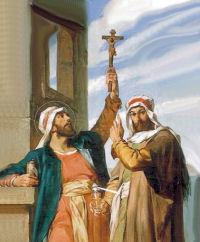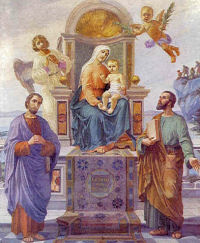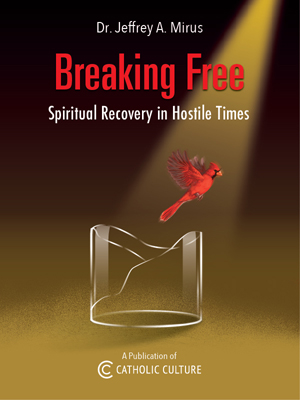Ordinary Time: September 26th
Tuesday of the Twenty-Fifth Week in Ordinary Time; Optional Memorial of Sts. Cosmas and Damian, Martyrs
» Enjoy our Liturgical Seasons series of e-books!
According to tradition, Saints Cosmas and Damian (d. 303) suffered martyrdom in Syria during the Roman persecution of Diocletian. Not much is known about them, but tradition holds they were twin brothers and medical doctors, never charging a fee for their medical services. Their names are in the Roman Canon of the Mass and they are honored in both the Eastern and Western Church and highly celebrated in Italian communities.
Sts. Cosmas and Damian
 This is one of the most ancient feasts of the Church, and these two martyrs have been honored in the East and West in many ways, including the building of churches in their honor in Rome and Constantinople. Along with St. Luke, they are the patron saints of doctors. Little is known of their true history, but the legend that has come down to us is of very early origin.
This is one of the most ancient feasts of the Church, and these two martyrs have been honored in the East and West in many ways, including the building of churches in their honor in Rome and Constantinople. Along with St. Luke, they are the patron saints of doctors. Little is known of their true history, but the legend that has come down to us is of very early origin.
Sts. Cosmas and Damian were venerated in the East as the "moneyless ones" because they practiced medicine gratis. According to the legend, they were twin brothers, born in Arabia, who studied in Syria and became skilled physicians. They were supposed to have lived on the Bay of Alexandretta in Cilicia, in what is now Turkey.
Since they were prominent Christians, they were among the first arrested when the great persecution under Diocletian began. Lysias, the governor of Cilicia, ordered their arrest, and they were beheaded. Their bodies, it was said, were carried to Syria and buried at Cyrrhus.
What is certain is that they were venerated very early and became patrons of medicine, known for their miracles of healing. The Emperor Justinian was cured by their intercession and paid special honor to the city of Cyrrhus where their relics were enshrined. Their basilica in Rome, adorned with lovely mosaics, was dedicated in the year 530. They are named in the Roman Martyrology and in the Canon of the Mass, testifying to the antiquity of their feast day.
The great honor in which they are held and the antiquity of their veneration indicate some historical memory among the early Christians who came out of the great persecutions with a new cult of Christian heroes. Cosmas and Damian were not only ideal Christians by their practice of medicine without fee, they also symbolized God's blessing upon the art of healing and that respect for every form of science, which is an important part of Christian tradition.
—Excerpted from The One Year Book of Saints by Rev. Clifford Stevens
Patronage: against blindness; against hernias; against kidney stones; against pestilence; apothecaries; barbers; blind people; chemical industry; chemical manufacturers; chemists; doctors; druggists; hairdressers; hernia patients; marital harmony; midwives; physicians; pharmacists; relief from pestilence; surgeons; Alberobello, Italy; Ossimo, Italy; Borgaro Torinese, Italy; Gaeta, Italy ;Tocco Caudio, Italy; Worshipful Company of Barbers
Symbols and Representation: A phial; phials and jars; vases; arrows; surgical instruments; lancet; red vestments; box of ointment; rod of Aesculapius (rod with serpent wrapped around, symbol of medicine); cylinder; stake and fagots; arrows; cross; swords; millstones
Highlights and Things to Do:
- Contemplate how these brothers imitated Christ by healing the WHOLE person, both body and soul.
- A Christian is generous: with his time, with his talents, with his money. Sts. Cosmas and Damian practiced medicine without charging others, looking upon this as a Christian service to others. I may not be able to imitate them in this, but my own spirit of generosity should be a clear part of my Christian witness.
- Pray for those in the medical field.
- Read more about Sts. Cosmas and Damian:
- See about the the Roman Church dedicated to Cosmas and Damian.
- See the statues on the St. Peter Basilica Colonnade for Cosmas and Damian.
- Find out more about the miracles attached to the relics of Cosmas and Damian. There are different relics in various locations, including Saint Michael’s Church in Munich, Germany and Rome.
- If you are close to Cambridge, Massachusetts on September 26, drop in on the annual Italian festival of the healing of Saints Cosmas and Damian which has been held since 1926 in September, close to their feast day.
- See Catholic Cuisine for a food idea for the Holy Twins.






